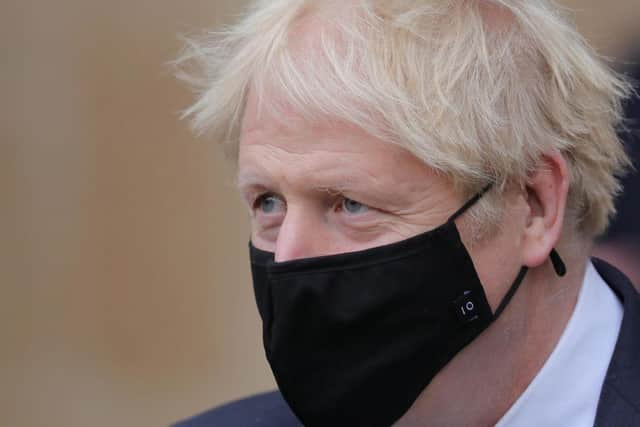When does lockdown end? Time England’s national restrictions are set to end in December - and when the tier system starts
and live on Freeview channel 276
Boris Johnson will outline the government’s winter strategy to combat coronavirus this afternoon (Monday 23 November).
The prime minister is set to announce a relaxation to Covid rules over Christmas – allowing people to celebrate the holiday with their families.
Advertisement
Hide AdAdvertisement
Hide AdBut this will only last for a few days with Mr Johnson expected to reintroduce the localised three tier alert system when lockdown comes to an end.


Ministers will detail on Thursday 26 November which local tier each area will be placed into and the rules around what can and can’t be done.
With the festive season fast approaching, all eyes are fixed on the government to see if the lockdown - introduced to control the spread of Covid - will end in December.
Mr Johnson set out the second lockdown restrictions on 5 November in an effort to get the virus under control amid rising infection rates and hospital admissions across England.
Advertisement
Hide AdAdvertisement
Hide AdThe PM had come under heavy pressure during October and early November to introduce stricter measures on society as daily case figures were consistently surpassing 20,000.
Leader of the opposition, Sir Keir Starmer, weighed in on the argument by calling for a short lockdown or “circuit breaker” to reduce the level of infections and prevent “a bleak winter”.
This was at a time when a new three-tier system for Covid restrictions in England was approved by MPs. The system placed each area of the country into a medium, high or very high alert category - each with their own set of restrictions for people to follow.
But as national numbers continued to rise the government implemented a second national lockdown, which the PM stated would last for only four weeks.
What are the lockdown rules for England?
Advertisement
Hide AdAdvertisement
Hide AdIn the main, the restrictions are designed to limit transmission of the virus while it’s still in circulation among society and reduce the R-rate to below 1.
As well as the general advice around washing hands, wearing a mask and maintaining social distancing, there are a handful of other key restrictions to be aware of.
The lockdown puts a temporary ban on different households from mixing indoors or in private gardens, unless it is part of a support bubble; forces pubs and restaurants to close, allowing takeaways; and sees non-essential shops, leisure and entertainment venues close.
People are encouraged to stay at home, only leaving for specific reasons such as education, work and food shopping, while schools, universities and colleges remain open.
Advertisement
Hide AdAdvertisement
Hide AdA full list of rules can be found on the government’s website.
What is the R-rate?
The R-rate is the reproductive rate measured to assess how prevalent the virus is in society.
If the R-rate is below 1 then it means the spread of the virus is getting smaller, as each infected person passes it on to less than one other person in theory.
The theory is that this leads to less infections and therefore less hospitalisations and deaths.
Advertisement
Hide AdAdvertisement
Hide AdIt is estimated to be between 1 and 1.1 as of 20 November 2020.
Is the second lockdown working?
Speaking at Monday’s Downing Street briefing, Matt Hancock said it was “too early for us to know” whether case numbers will be brought down sufficiently to ease the second lockdown.
When will England’s lockdown end?
England’s second lockdown is legally due to end on 2 December 2020.
Legislation states for the regulations to expire “at the end of the period of 28 days beginning with the day on which they come into force”.
Advertisement
Hide AdAdvertisement
Hide AdThe 2 December is the 28th day since the lockdown began on 5 November.
A government spokesperson has confirmed the national restrictions will be lifted at 00:01 on 2 December.
Could it be extended?
Yes. However, MPs would have to vote on extending the lockdown in parliament.
“It is our hope and expectation that that won’t be the case and that people in England will be able to move back into the tiered system,” MP Jenrick told Sky News.
Advertisement
Hide AdAdvertisement
Hide Ad“There will be a review. That work is undergoing on what those tiers look like and how local areas go back in but that will very much depend on the data.
“We will have to make decisions nearer the end of the month once we have got the most up-to-date information possible.
“But we all want to see a significant easing of the measures in all parts of England at the beginning of next month.”
What happens next?
The government then wants to return to a more localised approach in combating the virus through the three tier alert system.
Advertisement
Hide AdAdvertisement
Hide AdA review of the alert system is currently taking place, MP Jenrick confirmed.
What was the local three tier system prior to national lockdown?
The three tier system put restrictions on people’s movements to combat the spread of coronavirus, tailored to the specific area they live rather than a blanket national lockdown.
Areas were classified as medium, high or very high and the restrictions are as follows:
Advertisement
Hide AdAdvertisement
Hide AdMedium: Rule of Six - where you can only meet other people in groups of six or less - applies indoors and outdoors; 10pm curfew for pubs and restaurants.
High: Ban on different households mixing indoors; Rule of Six applies outdoors, pubs and restaurants to close at 10pm.
Very High: Different households are not allowed to mix indoors, outdoors, in hospitality venues or private gardens; Rule of Six applies in outdoor public spaces (parks); pubs and bars not serving meals will be closed; reduced travel in and out of the area and further measures can be agreed locally.
